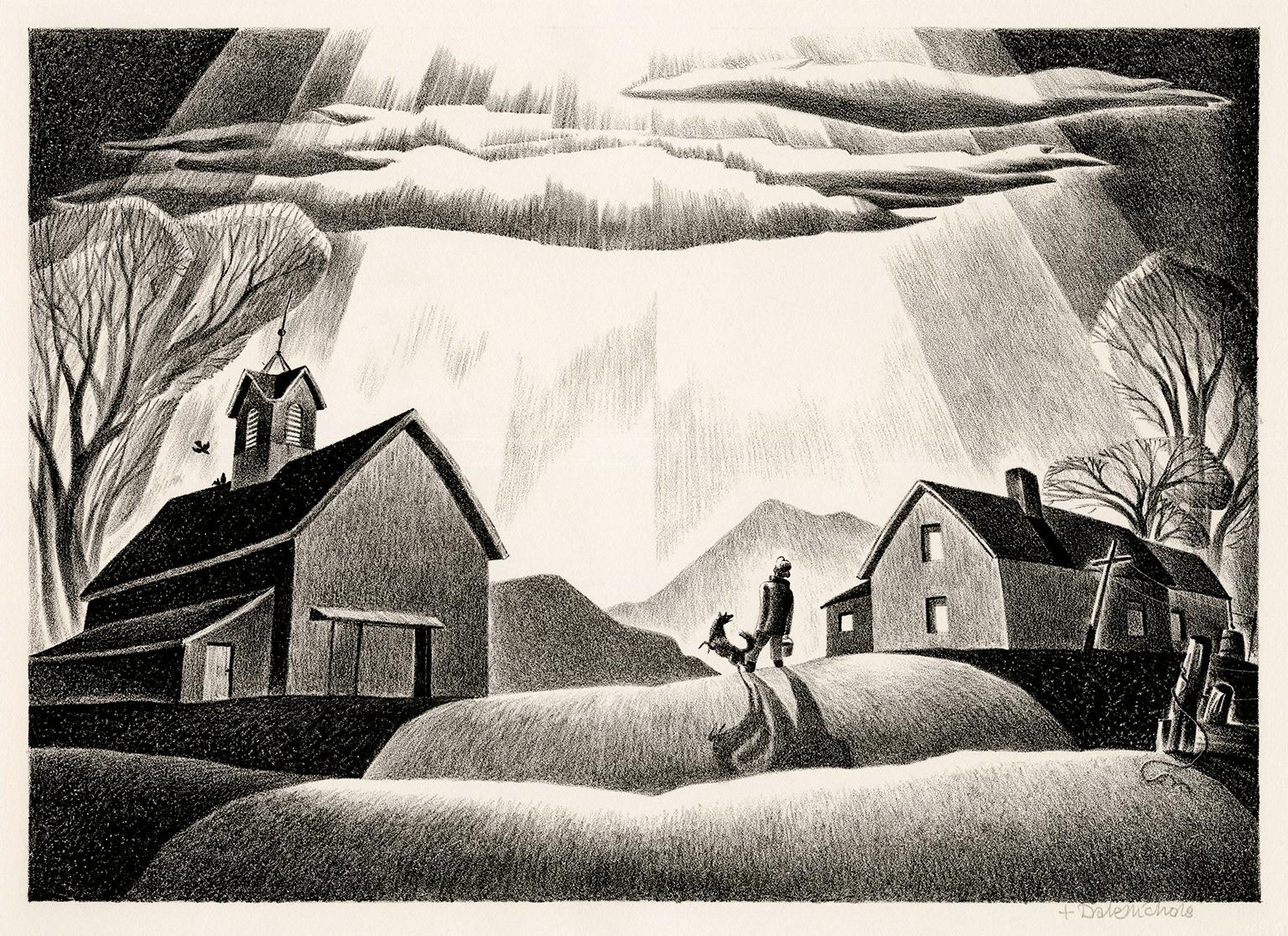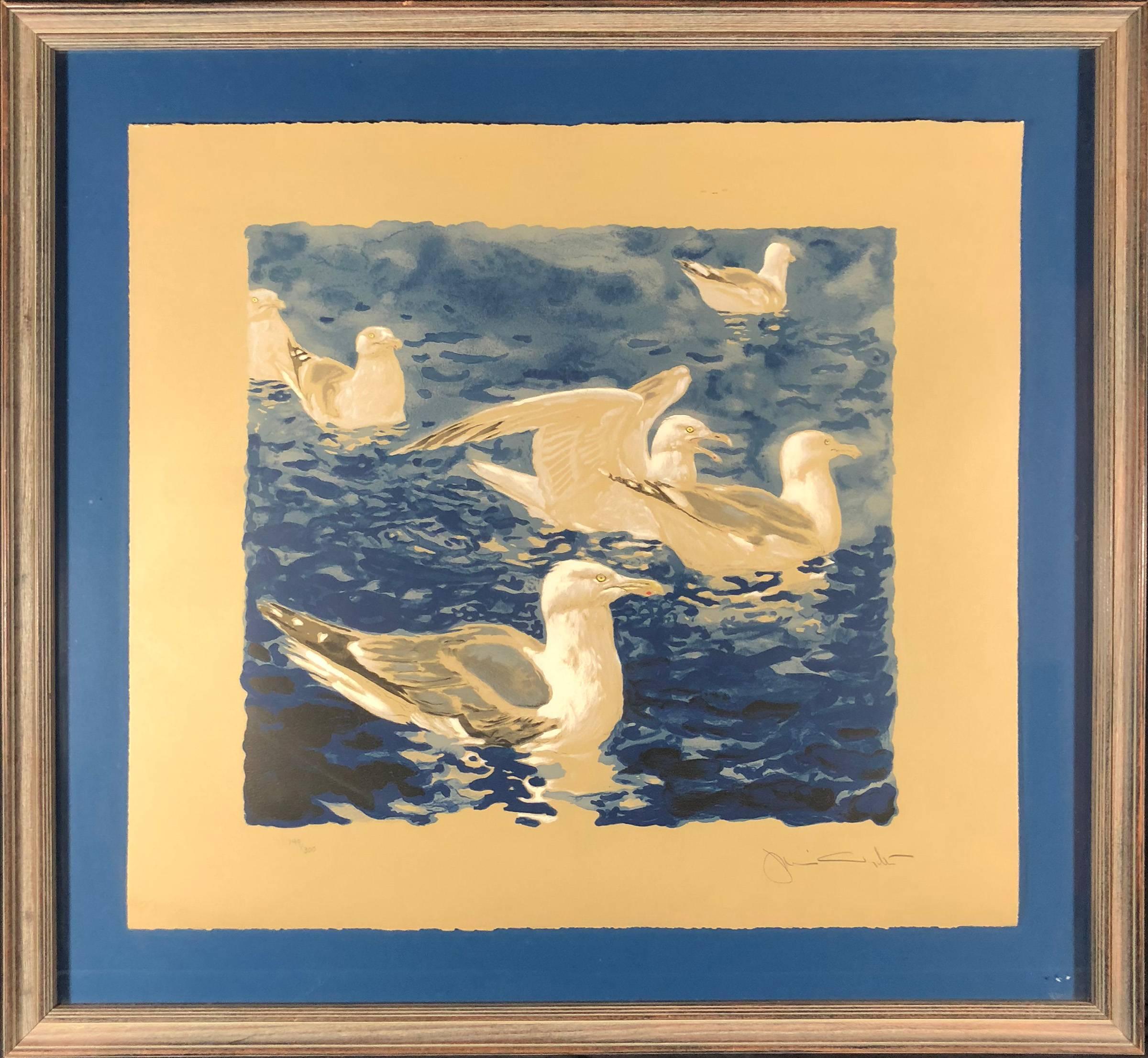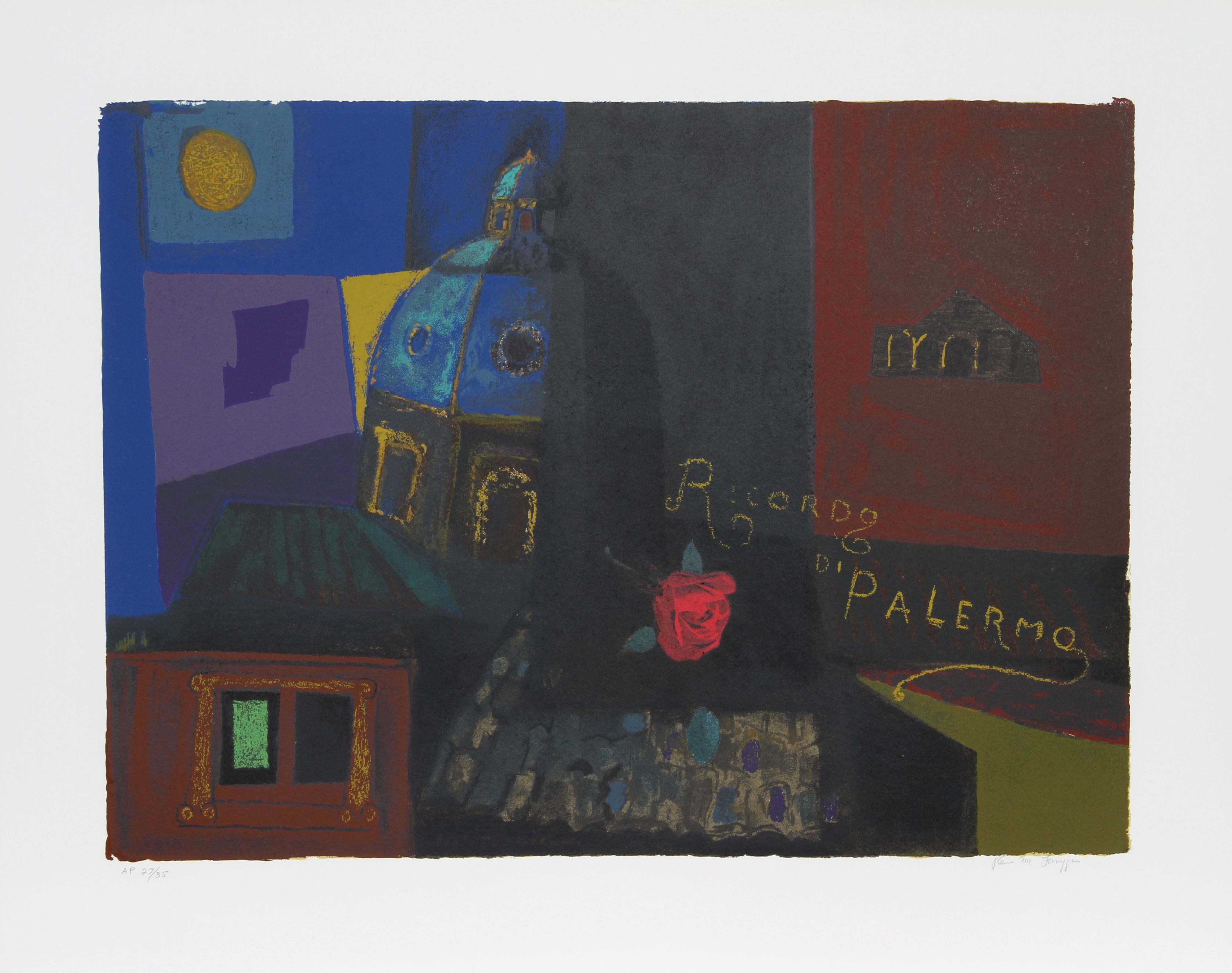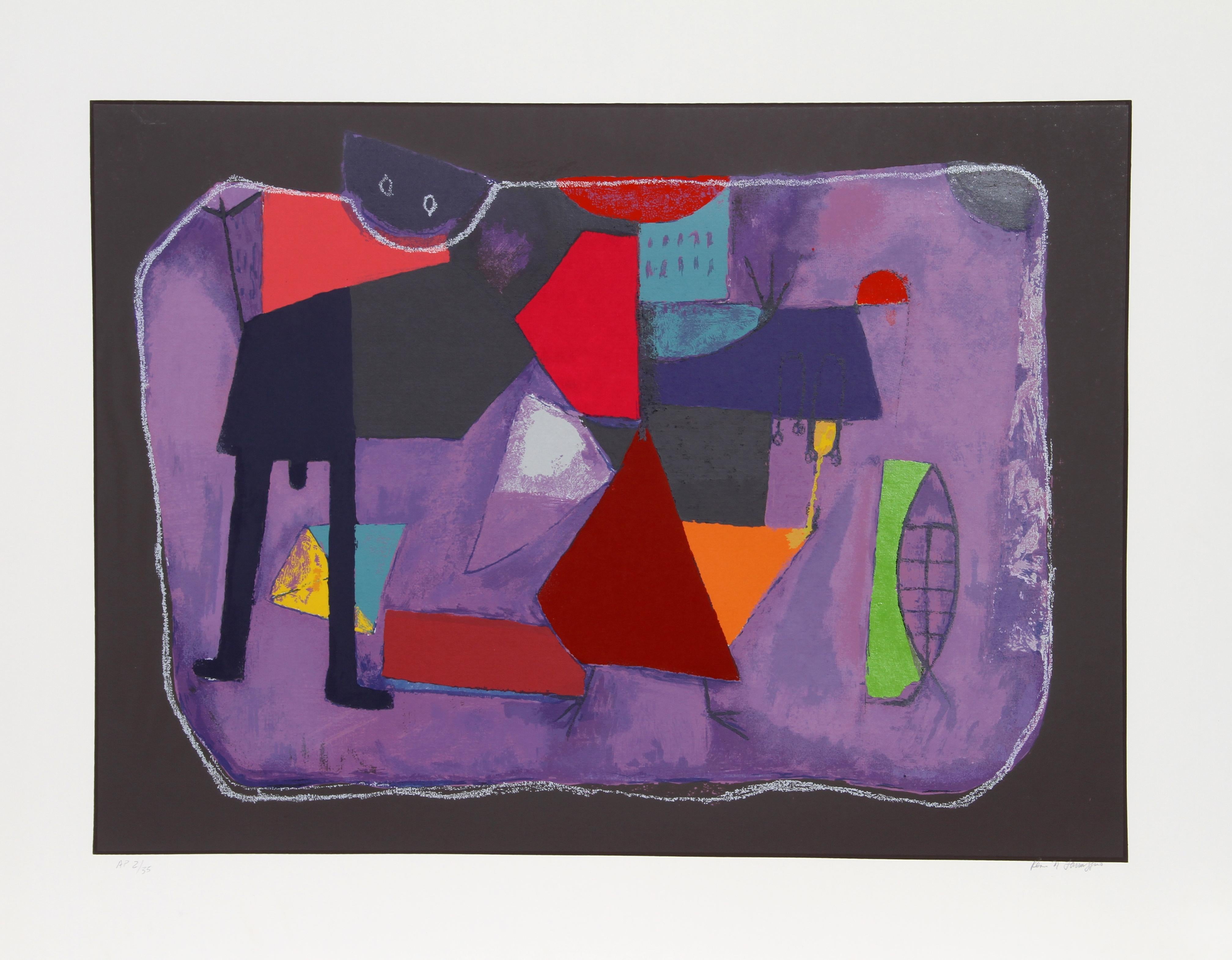Items Similar to Angry Skies (Andante Cantabile) — Central Park, New York City
Want more images or videos?
Request additional images or videos from the seller
1 of 3
Louis LozowickAngry Skies (Andante Cantabile) — Central Park, New York City1935
1935
About the Item
Louis Lozowick, 'Angry Skies (Andante Cantabile)', lithograph, 1935; edition 10, AAA 250; Flint 123. Signed in pencil. Signed in the stone, lower left. A fine, richly-inked impression, on cream, wove paper, with margins (7/8 to 1 3/16 inches), in excellent condition. Image size 9 5/8 x 13 1/2 inches; sheet size 11 7/8 x 16 1/8 inches. Matted to museum standards, unframed.
An impression from the second edition printed for Associated American Artists in 1948 by master lithographer George C. Miller.
Impressions of this work are in the following museum collections: Metropolitan Museum of Art, Portland Art Museum, Smithsonian American Art Museum, Whitney Museum of American Art.
ABOUT THE ARTIST
“A beautifully articulated synthesis of strong personal visions and an extraordinary command of black-and-white lithography remained constant. His prints have withstood the inevitable fluctuations of fashion and taste, and today are deservedly appreciated by both connoisseurs and a new generation as among the finest created in twentieth-century America.”
—Janet Flint, The Prints of Louis Lozowick: A Catalogue Raisonné, Hudson Hills Press, NY, 1982.
Born in Russia in 1892, Lozowick came to this country at the age of 14 to join his brother in New York City. By 1919 he had attended art school, finished college, served in the army, and traveled throughout the United States visiting major cities which would later become subjects of his work. From 1919 to 1924 Lozowick lived and traveled throughout Europe, staying in Paris, Berlin, and Moscow. While in Berlin he became friends with Laszlo Moholy-Nagy, El Lissitsky, and the avant-garde Russian artists affiliated with the November-gruppe. On his return to New York in 1924 he joined the executive board of the New Masses and exhibited his machine age drawings, the ‘Machine Ornament’ series in the 1926 exhibition of Katherine Dreier’s Société Anonyme; three years later he made his first prints.
Having assimilated European Constructivist and Cubist theories, and the Bauhaus manifesto promoting the integration of applied and fine art, Lozowick was inspired to present the rapidly growing New York City skyline with its monumental skyscrapers as modern symbols of optimism. Like many other Depression-era artists, he identified closely with the common worker and valued the consummate craft and workmanship dictated by the printmaking process. His versatility and range of interests were exemplified by his stage sets for the 1926 production of Georg Kaiser’s play “Gas,” the first Constructivist production seen in America. A year later, his images and essay were centerpieces in the pivotal 1927 Machine Age Exposition in New York. Lozowick’s first solo exhibition of lithographs depicting primarily soaring urban cityscapes and industrial scenes was mounted by the renowned Weyhe Gallery in 1929.
Assigned to the WPA New York Graphic Arts Division in 1935, he left in 1936 to accept a commission from the prestigious Treasury Relief Art Project for two large oil paintings for the Post Office at 33rd Street in Manhattan. His preliminary lithographic studies for the paintings are among his most compelling images of New York skyscraper and bridge forms.
Returning to the Project in 1938, Lozowick experimented with various printmaking mediums, including wood engraving, drypoint, and screen printing, until the end of his appointment in 1940. During the next three decades, encouraged by Carl Zigrosser of the Weyhe Gallery, he devoted himself primarily to lithography, mounting several solo exhibitions at major New York galleries, and a retrospective at the Whitney Museum of American Art in 1972. Posthumous solo and group exhibitions of Lozowick’s work include the Hirshhorn Museum and Sculpture Garden (2001), de Young Museum (2007), British Museum (2008), National Gallery of Art, Washington D.C. (2015), Whitney Museum of American Art (2015), Brooklyn Museum of Art (2015), and the Palmer Museum of Art (2019).
Louis Lozowick’s graphic works are held in numerous prominent museum collections including the Amon Carter Museum of American Art, Art Institute of Chicago, Baltimore Museum of Art, Brooklyn Museum, Cornell University Library, Museum of Fine Arts (Boston), Museum of Modern Art, New York Public Library, Philadelphia Museum of Art, Smithsonian American Art Museum, Walker Art Center, and the Whitney Museum of American Art.
- Creator:Louis Lozowick (1892 - 1973, American)
- Creation Year:1935
- Dimensions:Height: 9.63 in (24.47 cm)Width: 13.5 in (34.29 cm)
- Medium:
- Movement & Style:
- Period:
- Condition:
- Gallery Location:Myrtle Beach, SC
- Reference Number:
Louis Lozowick
Louis Lozowick is widely recognized as a key figure in America's Precisionist movement and a leader in mid-20th-century modernist printmaking. His graphic works and paintings have been acquired by numerous museums including the Art Institute of Chicago, Brooklyn Museum, Crystal Bridges Museum of American Art, Fine Arts Museums of San Francisco, Metropolitan Museum of Art, Museum of Modern Art, New York Public Library, Philadelphia Museum of Art, Smithsonian American Art Museum, U. S. Library of Congress and the Whitney Museum of American Art.
About the Seller
5.0
Recognized Seller
These prestigious sellers are industry leaders and represent the highest echelon for item quality and design.
Platinum Seller
These expertly vetted sellers are 1stDibs' most experienced sellers and are rated highest by our customers.
Established in 1995
1stDibs seller since 2016
258 sales on 1stDibs
Typical response time: 1 hour
Associations
International Fine Print Dealers Association
- ShippingRetrieving quote...Ships From: Myrtle Beach, SC
- Return PolicyA return for this item may be initiated within 7 days of delivery.
More From This SellerView All
- 'Partners' — Mid-Century Modernist RegionalismBy Dale NicholsLocated in Myrtle Beach, SCDale Nichols, 'Partners', lithograph, edition 250, 1950. Signed in pencil. A fine, richly-inked impression, on cream wove paper; the full sheet with margins (7/8 to 1 5/8 inches); tw...Category
1950s American Modern Landscape Prints
MaterialsLithograph
- 'Pulitzer Fountain, Evening" — 1940s American Modernism, New York CityBy Ellison HooverLocated in Myrtle Beach, SCEllison Hoover, 'Pulitzer Fountain, Evening', lithograph, circa 1940, edition c. 40. Signed in pencil. A fine, atmospheric impression, on cream wove paper; the full sheet with margins (1 1/2 to 4 5/16 inches), in excellent condition. Archivally matted to museum standards, unframed. Image size 12 1/2 x 9 5/8 inches (318 x 244 mm); sheet size 16 1/4 x 12 1/4 inches (413 x 311 mm). ABOUT THE SUBJECT The Pulitzer fountain was commissioned as a bequest by Joseph Pulitzer, newspaper publisher and founder of the Columbia School of Journalism. Designed by Austrian sculptor Karl Bitter...Category
Mid-20th Century American Modern Landscape Prints
MaterialsLithograph
- 'Navajo Trading Post' — 1940s Southwest RegionalismBy Ira MoskowitzLocated in Myrtle Beach, SCIra Moskowitz, 'Navajo Trading Post', lithograph, 1946, edition 30, Czestochowski 161. Signed and dated in the stone, lower left. A fine, richly-inked impression, on cream wove paper, with full margins (1 1/2 to 3 1/8 inches). Pale mat line, otherwise in excellent condition. Matted to museum standards, unframed. Image size 11 11/16 x 15 1/2 inches (297 x 395 mm); sheet size 16 5/16 x 191/8 inches (414 x 486 mm). ABOUT THE ARTIST Ira Moskowitz was born in Galicia, Poland, in 1912, emigrating with his family to New York in 1927. He enrolled at the Art Student's League and studied there from 1928-31. In 1935, Moskowitz traveled to Paris and then lived until 1937 in what is now Israel. He returned to the United States in 1938 to marry artist Anna Barry in New York. The couple soon visited Taos and Santa Fe in New Mexico, returning for extended periods until 1944, when they moved there permanently, staying until 1949. During this especially productive New Mexico period, Moskowitz received a Guggenheim fellowship. His work was inspired by the New Mexico landscape and the state’s three cultures (American Southwest, Native American, and Mexican). He focused on Pueblo and Navajo life, producing an extensive oeuvre of authentic American Indian imagery. He and Anna also visited and sketched across the border in Old Mexico. While in the Southwest, Moskowitz flourished as a printmaker while continuing to produce oils and watercolors. Over 100 of Moskowitz’s works depicting Native American ceremonies were used to illustrate the book American Indian Ceremonial Dances by John Collier, Crown Publishers, New York, 1972. After leaving the Southwest, printmaking remained an essential medium for the artist while his focus changed to subject matter celebrating Judaic religious life and customs. These works were well received early on, and Moskowitz was content to stay with them the rest of his life. From 1963 until 1966, Moskowitz lived in Paris, returning to New York City in 1967, where he made his permanent home until he died in 2001. Shortly before his death, Zaplin-Lampert Gallery of Santa Fe staged an exhibition of the artist's works, December 2000 - January 2001. Other one-person shows included the 8th Street Playhouse, New York, 1934; Houston Museum, 1941; and the San Antonio Museum, 1941. The artist’s work was included in exhibitions at the Art Students League, Art Institute of Chicago, Philadelphia Print Club, College Art Association (promotes excellence in scholarship and teaching), and the International Exhibition of Graphic Arts (shown at MOMA, 1955). Moskowitz’s lithographs of American Indian...Category
1940s American Modern Landscape Prints
MaterialsLithograph
- 'Navajo Courtship Dance' — 1940s Southwest RegionalismBy Ira MoskowitzLocated in Myrtle Beach, SCIra Moskowitz, 'Navajo Courtship Dance (Squaw Dance)', lithograph, 1946, edition 30, Czestochowski 161. Signed and titled in pencil. Signed and dated in the stone, lower left. A fine, richly-inked impression, on cream wove paper; the full sheet with margins (7/16 to 2 3/4 inches). Pale mat line, otherwise in excellent condition. Matted to museum standards, unframed. Image size 11 13/16 x 14 13/16 inches (300 x 376 mm); sheet size 13 1/16 x 20 1/8 inches (332 x 511 mm). ABOUT THE ARTIST Ira Moskowitz was born in Galicia, Poland, in 1912, emigrating with his family to New York in 1927. He enrolled at the Art Student's League and studied there from 1928-31. In 1935, Moskowitz traveled to Paris and then lived until 1937 in what is now Israel. He returned to the United States in 1938 to marry artist Anna Barry in New York. The couple soon visited Taos and Santa Fe in New Mexico, returning for extended periods until 1944, when they moved there permanently, staying until 1949. During this especially productive New Mexico period, Moskowitz received a Guggenheim fellowship. His work was inspired by the New Mexico landscape and the state’s three cultures (American Southwest, Native American, and Mexican). He focused on Pueblo and Navajo life, producing an extensive oeuvre of authentic American Indian imagery. He and Anna also visited and sketched across the border in Old Mexico. While in the Southwest, Moskowitz flourished as a printmaker while continuing to produce oils and watercolors. Over 100 of Moskowitz’s works depicting Native American ceremonies were used to illustrate the book American Indian Ceremonial Dances by John Collier, Crown Publishers, New York, 1972. After leaving the Southwest, printmaking remained an essential medium for the artist while his focus changed to subject matter celebrating Judaic religious life and customs. These works were well received early on, and Moskowitz was content to stay with them the rest of his life. From 1963 until 1966, Moskowitz lived in Paris, returning to New York City in 1967, where he made his permanent home until he died in 2001. Shortly before his death, Zaplin-Lampert Gallery of Santa Fe staged an exhibition of the artist's works, December 2000 - January 2001. Other one-person shows included the 8th Street Playhouse, New York, 1934; Houston Museum, 1941; and the San Antonio Museum, 1941. The artist’s work was included in exhibitions at the Art Students League, Art Institute of Chicago, Philadelphia Print Club, College Art Association (promotes excellence in scholarship and teaching), and the International Exhibition of Graphic Arts (shown at MOMA, 1955). Moskowitz’s lithographs of...Category
1940s American Modern Landscape Prints
MaterialsLithograph
- 'Navajo Medicine Ceremony of the Night Chant' — 1940s Southwest RegionalismBy Ira MoskowitzLocated in Myrtle Beach, SCIra Moskowitz, 'The Three Gods of Healing (Navajo Medicine Ceremony of the Night Chant)', lithograph, 1945, edition 30, Czestochowski 148. Signed and titled in pencil. Signed and dated in the stone, lower right. A fine, richly-inked impression, on cream wove paper, with full margins (2 1/4 to 2 3/4 inches), in excellent condition. Matted to museum standards, unframed. Image size 12 1/4 x 15 13/16 inches (311 x 402 mm); sheet size 17 1/8 x 20 7/8 inches (435 x 530 mm). ABOUT THIS WORK The nine-night ceremony known as the Night Chant or Nightway is believed to date from around 1000 B.C.E. when it was first performed by the Indians who lived in Canyon de Chelly (now eastern Arizona). It is considered the most sacred of all Navajo ceremonies and one of the most difficult and demanding to learn, as it encompasses hundreds of songs, dozens of prayers, and several highly complex sand paintings. And yet the demand for Night Chants is so great that as many as fifty such ceremonies might be held during a single winter season, which lasts eighteen to twenty weeks. The Night Chant is designed both to cure people who are ill and to restore the order and balance of human and non-human relationships within the Navajo universe. Led by a trained medicine man who has served a long apprenticeship and learned the intricate and detailed practices that are essential to the chant, the ceremony itself is capable of scaring off sickness and ugliness through techniques that shock or arouse. Once the disorder has been removed, order and balance are restored through song, prayer, sand painting, and other aspects of the ceremony. The medicine men who supervise the Night Chant ensure that everything—each dot and line in every sand painting, each verse in every song, each feather on each mask is arranged precisely, or it will not bring about the desired result. There are probably as many active Night Chant medicine men today as at any time in Navajo history due to the general increase in the Navajo population, the popularity of the ceremony, and the central role it plays in Navajo life and health. ABOUT THE ARTIST Ira Moskowitz was born in Galicia, Poland, in 1912, emigrating with his family to New York in 1927. He enrolled at the Art Student's League and studied there from 1928-31. In 1935, Moskowitz traveled to Paris and then lived until 1937 in what is now Israel. He returned to the United States in 1938 to marry artist Anna Barry in New York. The couple soon visited Taos and Santa Fe in New Mexico, returning for extended periods until 1944, when they moved there permanently, staying until 1949. During this especially productive New Mexico period, Moskowitz received a Guggenheim fellowship. His work was inspired by the New Mexico landscape and the state’s three cultures (American Southwest, Native American, and Mexican). He focused on Pueblo and Navajo life, producing an extensive oeuvre of authentic American Indian imagery. He and Anna also visited and sketched across the border in Old Mexico. While in the Southwest, Moskowitz flourished as a printmaker while continuing to produce oils and watercolors. Over 100 of Moskowitz’s works depicting Native American ceremonies were used to illustrate the book American Indian Ceremonial Dances by John Collier, Crown Publishers, New York, 1972. After leaving the Southwest, printmaking remained an essential medium for the artist while his focus changed to subject matter celebrating Judaic religious life and customs. These works were well received early on, and Moskowitz was content to stay with them the rest of his life. From 1963 until 1966, Moskowitz lived in Paris, returning to New York City in 1967, where he made his permanent home until he died in 2001. Shortly before his death, Zaplin-Lampert Gallery of Santa Fe staged an exhibition of the artist's works, December 2000 - January 2001. Other one-person shows included the 8th Street Playhouse, New York, 1934; Houston Museum, 1941; and the San Antonio Museum, 1941. The artist’s work was included in exhibitions at the Art Students League, Art Institute of Chicago, Philadelphia Print Club, College Art Association (promotes excellence in scholarship and teaching), and the International Exhibition of Graphic Arts (shown at MOMA, 1955). Moskowitz’s lithographs of...Category
1940s American Modern Landscape Prints
MaterialsLithograph
- 'Navajo Horse Race' — 1940s Southwest RegionalismBy Ira MoskowitzLocated in Myrtle Beach, SCIra Moskowitz, 'Navajo Horse Race', lithograph, 1946, edition 30, Czestochowski 204. Signed and titled in pencil. Signed and dated in the stone, lower le...Category
1940s American Modern Landscape Prints
MaterialsLithograph
You May Also Like
- Original Cadiz Fiestas Tipicas Gaditanas vintage Spanish festival travel posterLocated in Spokane, WAOriginal Cadiz, Fiestas Tipicas Gaditanas vintage lithograph poster. This fun image is professionally archival linen backed in very good condition, ready to frame. Artist: Ricardo Anaya. The image features a sailboat with a group of colorful people aboard. A pirate, witch, male and female flamingo...Category
1960s American Modern Figurative Prints
MaterialsLithograph
- Highbridge (Harlem River, New York City)Located in Middletown, NYLithograph on bluish green wove paper, 8 3/4 x 5 3/4 inches (223 x 146 mm), full margins. In very good condition with no visible defects. A dramatic 19th century view of the Harlem ...Category
Early 20th Century American Modern Landscape Prints
MaterialsLithograph
- Cat and BusybodyBy Benton Murdoch SpruanceLocated in Middletown, NYA 1933 lithograph on cream wove paper 14 x 18 inches (354 x 452mm), full margins. Signed, titled, and numbered 17/33 in pencil, lower margin. Minor mat tone around the perimeter of t...Category
1930s American Modern Landscape Prints
MaterialsLithograph
- Philip Cheney, April ThawLocated in New York, NYThis peaceful, idyllic scene is a perfect example of works published by Associated American Artists in the 1940s -- an American subject, drama-free, and masterfully drawn. It was iss...Category
Mid-20th Century American Modern Landscape Prints
MaterialsLithograph
- Joseph S. Sims, The Mills of Manayunk (Pennsylvania)Located in New York, NYThis print is signed, titled, and dated, in pencil. Manayunk was an industrial town to the north of Philadelphia.Category
Mid-20th Century American Modern Landscape Prints
MaterialsLithograph
- Alice Harold Murphy, The Wave and the RockLocated in New York, NYThis is an enigmatic image. Between the two center/left trees there appears to be a figure, possibly a woman. At the right, seated on a rock, is a man, in robes. Religious images are...Category
Mid-20th Century American Modern Figurative Prints
MaterialsLithograph
Recently Viewed
View AllMore Ways To Browse
Black And Cream Modern Art
Urban Garden Print
Vintage New York City Skyline
Manhattan Skyline Oil Painting
Russian Constructivist
George Washington Engraving
Aaa Sign
Bridge At Central Park
Gruppe Oil Painting
Vintage Gas And Oil
Chicago Skyline Painting
Vintage Engraving Machine
A C Palmer
Wpa Stone
George Washington Bridge
Skyline 1930
Palmer Sculpture
Metropolitan Ornament





